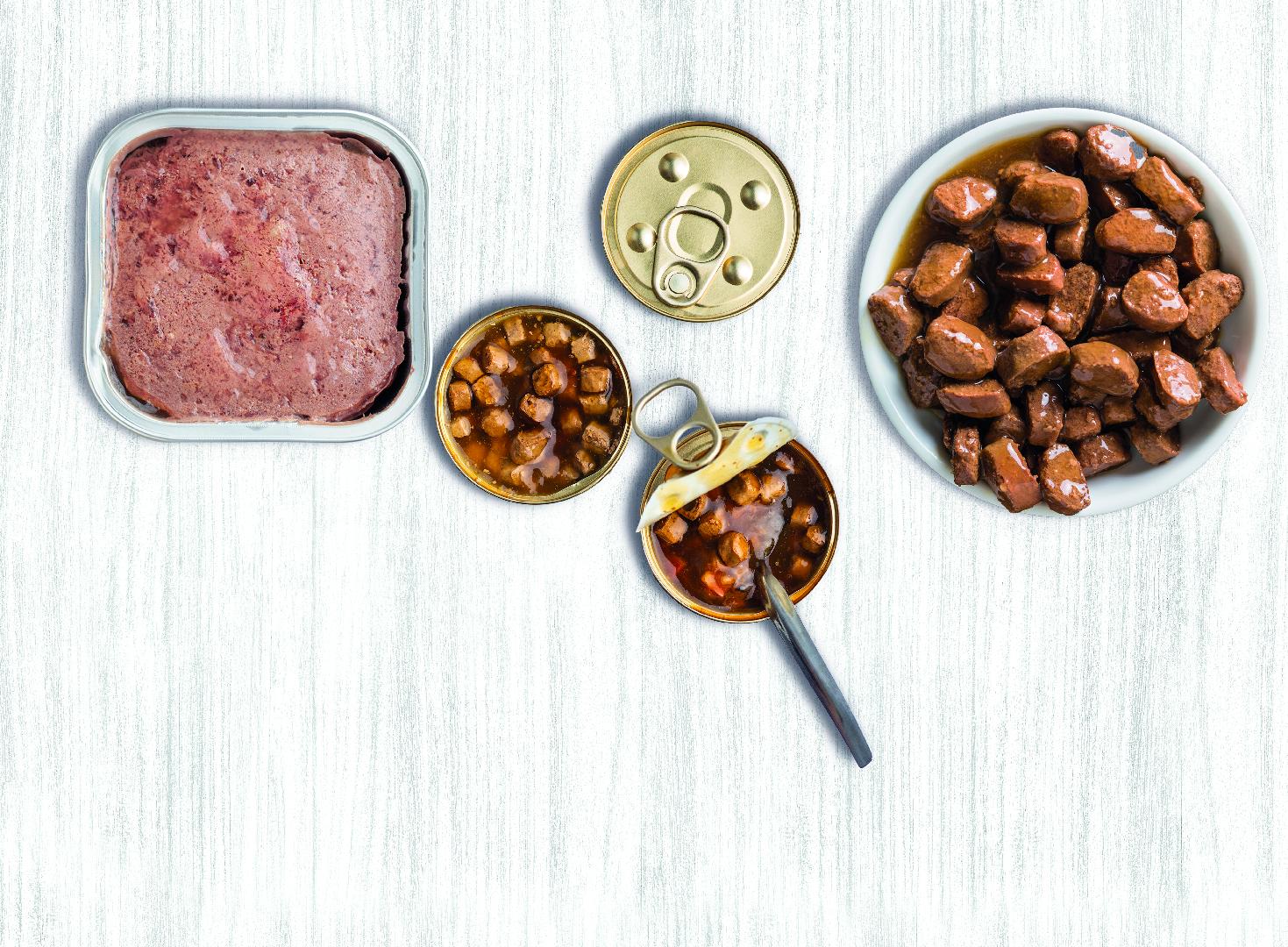According to Euromonitor, in 2021, the volume of wet pet food sold in Brazil was approximately 72,000 tons, with a turnover close to 2 billion brazilian reais. This results in a growth of 18% for wet food for cats, and 5% for dogs in the year 2021, compared to 2020.
Moist foods, those with humidity greater than 60% according to FEDIAF (2021), are the ones that most resemble fresh foods, which in turn refer guardians to the feeling of providing health and wellbeing to their pets through the food.
The development of wet food differs from dry extruded on several points, one being processed. Among many process options, we have extrusion, moist or dry heat cooking, autoclave sterilization, and freezing, among other technologies that guarantee the quality and safety of the final product. But, in addition to the production process, we point out other factors that we consider important in the development of this category of food.
Formulation
Initially, the formulation of wet foods differs in the choice of ingredients. We can use cereals, flours, and bran in the formula, but there is the possibility of using inputs with a lot of moisture, such as fresh meats and organ meats, vegetables, and fruits, in addition to other sources of nutrients that are limited in the composition of dry foods.
As the natural moisture of the ingredients is still present in the final product, its energy density is lower since the nutrients are more diluted. Therefore, in moist and semi-moist food, even if they are complete, the metabolizable energy tends to be up to 4 times lower than in dry extruded food.
The metabolizable energy (ME) of cat and pet food is the most accurate measure to express its energy density. The way to calculate the ME of food can be through live digestibility or through prediction equations. Recent studies (Calvez J et al. 2012a, Calvez J et al. 2012b) that compare the precision between the modified Atwater method versus the equations cited by the National Research Council (NRC, 2006) to estimate ME have shown that both provide an equally moderate precision of estimation of the ME, for wet food for dogs and cats.
Therefore, formulating the complete wet feed using the FEDIAF (2021) recommended nutrient profile table, based on caloric content rather than dry matter, is the best option to ensure that the requirements of each essential nutrient will be consumed (every 1000 ME kcal of food intake).
Palatability
The nutritional composition and functional benefit claims attributed that pet food is a strong influence on the owner's purchase decision. However, it is useless to offer pets a correctly balanced food with functional ingredients if it does not consume it.
To ensure the correct consumption of industrialized food, whether dry, semi-moist, or moist, it must be tasty and stimulate the pet's appetite through factors known by the pet food industry as "palatability drivers". For this reason, having scientific proof of dogs' and cats' food preferences is essential to develop a palatability agent and test its performance in the product intended.
Wet food, by itself, is already recognized by guardians as more palatable or attractive to pets than dry foods. However, the basic composition of the product, the type of processing, the palatability, and the type of packaging, in addition to the pet's eating habits and familiarity with this category, still have an influence.
Palatabilizers can be found in liquid or powder form and are produced through the process of enzymatic hydrolysis of animal products and their main function is to attract the dog or cat through the release of aromatic molecules when food is offered. After being applied to the food, palatability measurements must be carried out in specialized panels to verify the increase in performance provided by the additive.
The factors that drive palatability in wet food still need to be further explored, but it is already known that the use of plants in the formulation has the ability to increase its appeal compared to the same version without them.
Water activity (AW)
The control of water activity in dry or wet-processed foods is essential to ensure their quality. The water must not remain entirely in the form of free water since it acts as a means of dispersing nutrients for the development of microorganisms and chemical-enzymatic reactions. To prevent the activity of fungi, yeasts, and bacteria in dry extruded food combined methods are often used, such as drying or dehydration, so that the wáter activity reaches between 0.6 and 0.62.
In the case of moist food, high water activity is normal, which if not adjusted will approach 1, reducing its shelf life. To reduce these, we can add solutes, pH control, and conservation methods. However, there is still the possibility of increasing the occurrence of enzymatic and non-enzymatic browning reactions, including fat rancidity, which makes difficult its process (and antioxidants and acids are used to lower the pH).
Even so, free water is necessary so that the sensory qualities (softness, chewiness, palatability, among others) are the best possible. In general, in moist and semi-moist products for dogs and cats, we reduce aw with the use of technological additives such as thickeners, stabilizers, and emulsifiers: gums, glycerin, lecithin, propylene glycol, carboxymethylcellulose and even ingredients that also help reduce it, such as starches, sugars and sources of soluble fiber.
By: Eliane Gil Gatto, Ludmila Barbi and Erika Stasieniuk
You could be interested: Understanding Minimally Processed: What It Really Means for Your Pets Food
About author
Ludmila Barbi T. BomcompagniBrazilian living in Mexico City, veterinarian with a master's degree in Animal Nutrition. Having experience in pet food formulation and raw materials evaluation, she currently dedicates to the study and development of functional additives for pet food nutrition.
About author
Erika StasieniukAnimal Scientist graduated from UNESP —Botucatu, with a Master’s degree (2009) and Ph.D. (2013) in Animal Science, with an emphasis on Companion Animal Nutrition, from UFMG— Belo Horizonte. With over 15 years of experience in the pet food industry, she has worked in Research and Development, formulation of dry extruded foods, premixes, and supplements for dogs, cats, and fish, with experience in both national and multinational companies. Since 2019, she has been the founder of SFA Consultoria, providing technical and strategic support to national and international companies that produce food and ingredients for dogs and cats. She also trains professionals through online courses and mentorships, with more than 200 students in Brazil and abroad. She is currently also a postgraduate professor at Faculdade CTA, where she teaches the subject of Dry Extruded Food Formulation for Dogs and Cats. You can find her on Instagram: @erikastasieniuk






































